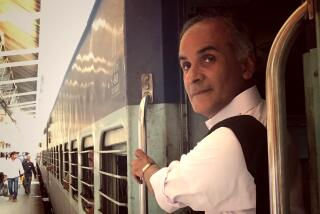A Bizarre Journey to Bacchanalia
- Share via
One may journey to Brazil by leisurely trains, fast airplanes or slow boats to Rio de Janeiro.
Simon Mayle drove there in a hearse.
Not to make a delivery, or a pickup, you understand, but to get loose and legless with the rest of Latin America during a one-week hooley on Copacabana Beach called Carnaval. And then write a book about his incredible journey, binge and lust fest.
But why in heaven’s name--now, there’s an apt phrase--go there in a hearse? Fact is, explains Mayle in “The Burial Brothers” (Ballantine Books), it’s a genius idea when one realizes it’s a dead market, as it were, for used casket carriers. So an unblemished Cadillac with only two owners and 31,000 miles on its 9.5-liter V8 can be stolen for $3,500.
“The 31,000 on the clock would be original miles, because how far is it going to be from funeral home to cemetery and back, five times a week, 52 weeks of the year, even over 20 years?” writes Mayle. “Also, as everyone knows, a hearse probably never tops out at more than 30 mph during its working career, and the only thing you’re likely to strain is the patience of the man behind you.”
With padding over the rollers, there’s also nine feet of sleeping space in the back. Also privacy curtains, three light fixtures and an inverted bathtub for a ceiling. Plus an iconoclastic image guaranteed to appeal to any irreverent writer whose naked prose revives Jack Kerouac and Ken Kesey: A hearse always upsets people, and the devout will be compelled to genuflect.
Better yet, even in regions where the ruling classes are bandits and drug dealers, undertakers are rarely considered carriers of precious cargoes. That’s why Mayle traveled in a rented silk hat and Hasidic topcoat.
And so a first-time author began his trip to “the other side of 15,000 miles, 13 frontiers, two or three war zones, two tropics, the equator and the mighty Andes. All of it to get through. In about six weeks. In an old hearse. I did not anticipate any problems with this.”
Nor did his co-driver and equally sick puppy, Lenny, an artist suddenly freed up for this odd odyssey when he was kicked out of his job, his marriage and his home in one day.
For those 15,000 miles, they drank vodka martinis and threw hamburger wrappers under the seats, listened to “Teach Yourself Spanish” tapes, and picked up any hitchhiker who wasn’t carrying an AK-47. They carried spare gas cans in a child’s coffin donated in New Orleans; were joined by Tarris, an oil-fields roughneck in Mexico City; bribed border officials to get into Guatemala; and obtained local dinero for El Salvador from a 9-year-old money changer.
Martinis gave way to roadies that blended vodka, mescale and tequila. Days graduated to nights in the local whorehouse. There was an abortive cocaine buy that almost got the three murdered in Colombia, and a surfing lesson that almost drowned Mayle in Ecuador.
In the end, Lenny and Tarris decided not to keep up with the Indiana Joneses and headed home. But Mayle made it all the way to “seven long day and nights of around-the-clock dancing, drinking, fighting, fireworks, floats, costumes, samba bands, celebrity parties, block parties, house parties, street parties, roof parties, beach parties and bar crawls.”
It’s a tough tale, somewhat tawdry around the edges, but told well. It is ribald, often touching, enormously offbeat and a full testimony to the human bonding of experiences survived. This slender paperback is cool the way such writings and times used to be hip, and to paraphrase a worn philosophy: A trip unexamined simply isn’t worth driving.
More to Read
Sign up for The Wild
We’ll help you find the best places to hike, bike and run, as well as the perfect silent spots for meditation and yoga.
You may occasionally receive promotional content from the Los Angeles Times.






